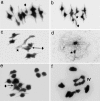Diploid apomicts of the Boechera holboellii complex display large-scale chromosome substitutions and aberrant chromosomes
- PMID: 17704257
- PMCID: PMC1955788
- DOI: 10.1073/pnas.0706647104
Diploid apomicts of the Boechera holboellii complex display large-scale chromosome substitutions and aberrant chromosomes
Abstract
We conducted a cytogenetic study of sexual lines of Boechera stricta and Boechera holboellii (2n = 14) and seven diploid apomictic accessions of their interspecific hybrid Boechera divaricarpa and B. holboellii (2n = 14 or 15). By studying chromosome morphology, rDNA repeats, genome painting, male meiosis, pollen morphology, and flow-cytometry seed screens, we revealed an unexpected plethora of chromosome forms, pairing behavior, and hybrid composition in all apomictic lines. Genome painting demonstrated that the apomicts are alloploid with variable numbers of B. stricta and B. holboellii-like chromosomes. We assume that large-scale homeologous chromosome substitutions took place in the apomictic hybrids that resulted from recurrent diploid-polyploid transitions through restitutional meiosis and polyploidy-diploid transitions through reductional meiosis. A second peculiarity was the presence of a largely heterochromatic chromosome (Het) in all apomictic accessions (2n = 14 and 15) and an additional smaller chromosome (Del) in the aneuploids (2n = 15). Both chromosomes share repetitive pericentromere repeats with those from the sexual B. stricta, suggesting that they originated from this species. Pairing and behavior at meiosis I of the Het share features with both Y and B chromosomes and suggest that the Del arose from a translocation event or homeologous recombination between a B. holboellii (or related taxon) and a B. stricta chromosome. Based on its presence exclusively in apomictic accessions, we propose that the Het chromosome plays a role in the genetic control of apomixis.
Conflict of interest statement
The authors declare no conflict of interest.
Figures





Similar articles
-
Is the aneuploid chromosome in an apomictic Boechera holboellii a genuine B chromosome?Cytogenet Genome Res. 2004;106(2-4):173-83. doi: 10.1159/000079284. Cytogenet Genome Res. 2004. PMID: 15292588
-
Biogeographic distribution of polyploidy and B chromosomes in the apomictic Boechera holboellii complex.Cytogenet Genome Res. 2005;109(1-3):283-92. doi: 10.1159/000082411. Cytogenet Genome Res. 2005. PMID: 15753588
-
Karyotype evolution in apomictic Boechera and the origin of the aberrant chromosomes.Plant J. 2015 Jun;82(5):785-93. doi: 10.1111/tpj.12849. Plant J. 2015. PMID: 25864414
-
The Boechera Genus as a Resource for Apomixis Research.Front Plant Sci. 2019 Apr 2;10:392. doi: 10.3389/fpls.2019.00392. eCollection 2019. Front Plant Sci. 2019. PMID: 31001306 Free PMC article. Review.
-
Chromosome 'speed dating' during meiosis of polyploid Brassica hybrids and haploids.Cytogenet Genome Res. 2008;120(3-4):331-8. doi: 10.1159/000121082. Epub 2008 May 23. Cytogenet Genome Res. 2008. PMID: 18504362 Review.
Cited by
-
Boechera microsatellite website: an online portal for species identification and determination of hybrid parentage.Database (Oxford). 2017 Jan 1;2017(1):baw169. doi: 10.1093/database/baw169. Database (Oxford). 2017. PMID: 28365726 Free PMC article.
-
Differential effects of polyploidy and diploidy on fitness of apomictic Boechera.Sex Plant Reprod. 2012 Jun;25(2):97-109. doi: 10.1007/s00497-012-0181-8. Epub 2012 Feb 25. Sex Plant Reprod. 2012. PMID: 22367230
-
Geographical Parthenogenesis in Alpine and Arctic Plants.Plants (Basel). 2023 Feb 13;12(4):844. doi: 10.3390/plants12040844. Plants (Basel). 2023. PMID: 36840192 Free PMC article. Review.
-
The Rise of Apomixis in Natural Plant Populations.Front Plant Sci. 2019 Apr 2;10:358. doi: 10.3389/fpls.2019.00358. eCollection 2019. Front Plant Sci. 2019. PMID: 31001296 Free PMC article. Review.
-
Identifying the fitness consequences of sex in complex natural environments.Evol Lett. 2020 Sep 30;4(6):516-529. doi: 10.1002/evl3.194. eCollection 2020 Dec. Evol Lett. 2020. PMID: 33312687 Free PMC article.
References
-
- Koch M, Bishop J, Mitchell-Olds T. Plant Biol. 1999;1:529–537.
-
- Kantana L. Wageningen, The Netherlands: Wageningen Univ; 2005. PhD thesis.
-
- Dobeš C, Mitchell-Olds T, Koch M. Mol Ecol. 2004;13:349–370. - PubMed
-
- Dobeš C, Sharbel TF, Koch M. Syst Biodiversity. 2007;5:321–331.
-
- Koch MA, Dobeš C, Mitchell-Olds T. Mol Biol Evol. 2003;20:338–350. - PubMed
MeSH terms
Substances
LinkOut - more resources
Full Text Sources

